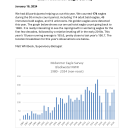
Birding
At Blackwater NWR, the best time for viewing waterfowl is between mid-October and mid-March. Wintering species include tundra swans, Canada and snow geese, and over 20 species of ducks. The most common ducks found here are mallards, black ducks, blue-winged teal, green-winged teal, wigeon, and pintails. Although most waterfowl migrate north in the spring, some remain through the summer, using the protected areas of the Refuge to raise their young. These nesting waterfowl include Canada geese, mallards, black ducks, wood ducks, and blue-winged teal.
Want to know what birds have been recently seen at the refuge? We suggest visiting Cornell's eBird page for Blackwater. There you can see all the bird sightings that have recently been logged by refuge visitors. Better yet, join the eBird community and contribute to the sightings list!
Road Etiquette: When stopping to view wildlife along public roads, please be sure to get as far off the road as safely possible and turn on your hazard lights. Do not park near a blind corner, and do not block traffic. This will ensure the safety of visitors and residents alike.
Update 12/28/2024: The Marsh Edge Trail and its parking lot is currently CLOSED TO ALL ENTRY because of bald eagle nesting activity.
Waterfowl Surveys
Blackwater NWR biologists and trained volunteers conduct waterfowl surveys primarily in the fall and winter. Unless otherwise noted, these are ground surveys. The biologists approximate the number of birds by driving a predetermined route around the refuge property. These surveys provide a "snapshot" of the waterfowl present at the refuge during a given week. A spreadsheet of the weekly surveys can be found below.
Update January 17, 2025: With the first count of January, we have begun a new spreadsheet for Winter 2025. The winter aerial waterfowl survey and the annual eagle survey have also been added.












